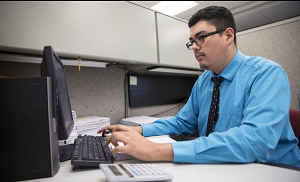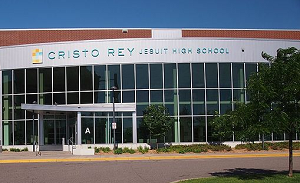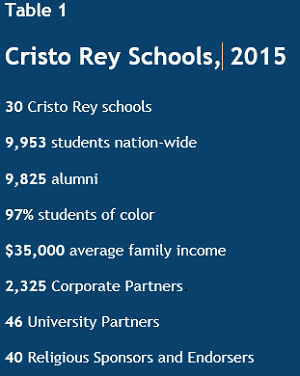Cristo Rey Schools are often discussed in the context of other innovations that could save Catholic schooling from decline. For at Cristo Rey high schools, students are able to pay up to 70 percent of their own tuition at a high-quality Catholic school by working one full day per week at a job in a professional setting arranged by their school. While the financial benefits of this arrangement are great for the students and their families, even more significantly, it may be the way that the Cristo Rey schools help students build their own “social capital” by learning skills and attitudes that will help them succeed in life.
How It Works to Work

The 32 Cristo Rey Catholic schools in the United States give their students a “day off” from school during the week to work in a nearby business or office, earning money to help pay for their private schooling. Students are employed one day per week by professional organizations, known as Corporate Work Study Partners. Students still attend high school classes four days per week on a bell schedule slightly lengthened to compensate for time spent at work. This model makes work an activity that enhances the education experience in two very different settings: one professional, the other academic. As one worker explained, “I learned more because I did it instead of just talking about it.”
Cristo Rey Schools limit tuition to about $12,000 annually with the average family paying about $3,500. A report on students’ earning part of their own tuition from Cristo Rey Jesuit High School in Chicago is as follows:
To make up the time [lost working] the other four days, they have fewer electives, a longer school day that runs from 8:30 a.m. to 3:30 p.m., and a 10-month school calendar.
They earn roughly 70 percent of their own tuition, cutting what would typically be an $11,000 or $12,000 annual tuition to $3,000 or below, and 90 percent of families are given need-based scholarships to cover that portion.[i]
Most Cristo Rey students after graduation have been accepted to college, with many getting into their first choice. As one Cristo Rey school reported,
‘Cristo Rey High School’s first graduating class learned Friday that all 86 seniors got accepted into four-year colleges: “’It was a promise that we made to families that we didn’t have any teachers, we didn’t have any books, we didn’t have a school, but we had a dream and a promise,’ said Dr. Michael Gomez, principal.”[ii]
A Cristo Rey school is described with these qualities:
1. Is explicitly Catholic in mission and enjoys Church approval.
2. Serves only economically disadvantaged students. The school is open to students of various faiths and cultures.
3. Is family centered and plays an active role in the local community.
4. Shall prepare all of its students to enter and graduate from college.
5. Requires participation by all students in the work-study program. All students must be 14 years old by September 1.
6. Integrates the learning present in its work program, classroom and extracurricular experiences for the fullest benefit of its student workers.
7. Has an effective administrative and board structure as well as complies with all applicable state and federal laws.
8. Is financially sound and at full enrollment the school is primarily dependent on revenue from the work-study program to meet operating expenses. In addition, the school maintains a comprehensive advancement program to ensure financial stability.
9. Supports its graduates’ efforts to obtain a college degree.
10. Is an active participant in the collaboration, support, and development of the Cristo Rey Network. [iii]
Jesuits often are principals of Cristo Rey schools, and they bring God’s blessing to the effort. As the principal of a Cristo Rey school offered on one occasion:
Greetings Students: I challenge you to work hard to accomplish your goals of graduating from high school and college, but also to strive to be leaders in your communities. Your Jesuit education is unique in that it fosters not just the mind, but encourages you to grow in the image of God. Take advantage of our rigorous curriculum, work, spiritual and extra-curricular opportunities so that you may live out the true spirit of Ad Majorem Dei Gloriam [“for the greater glory of God”]. (Dave Mason, Principal )
Cristo Rey School in New York City
The Cristo Rey New York High School is in East Harlem, a half-block from Park Avenue.[iv] The school, founded in 2004, operates in a renovated, brick-faced 19th-century building that once served as a tenement house and later a convent. The school enrolls 393 students, 80 percent of whom are Latino. More than 50 percent are girls. Students must come from low-income families who, except for the Cristo Rey program, would not be able to send their child to an academically superior private school.
Students in the school in New York City work one day per week in teams of five, with each student covering one of the week’s five workdays at the employer. New York work-study sites and sponsors are heavily weighted toward the finance and insurance industries, involving firms such as Deutsche Bank, JP Morgan Chase, Morgan Stanley, New York Life, and MetLife. Other corporate and community clients represent law, the media, health care, accounting, education, real estate, and more.
The Cristo Rey model has five critical qualities that could be used to educate children everywhere.
1. Children Pay for Their Own Education. The Cristo Rey model helps poor children to pay their own way in getting an education, long called “work-study.”
2. Children Learn to Work. Learning to be responsible at work is critical part of children’s education.
3. Students Have a Dress Code. Learning to dress appropriately is important for poor children as they move into a career often in white-collar professional jobs.
4. Professional Conduct. Cristo Rey schools place students in real work environments where they are expected — and taught — to speak clearly and act like adults, responding to queries and looking people in the eye when conversing with them.
5. Networking. Often the work-study employers of these children act as future employers or help these inner-city kids find and keep jobs after college and beyond. Their internship site becomes a possible career and employers often write valuable recommendation letters later.
These schools help children and families “catch up” financially, socially, and educationally with their middle-class counterparts. As one family member told the New York Times, “A smiling, confident 14-year old knows he has a kind of opportunity that his parents hoped [for] when they left all they knew in Mexico for unknown chances in East Harlem.”

This investment in human development and life (i.e., human capital) can and should start when children are still in school – helping them to learn and progress. These kinds of working-and-learning opportunities were long available in rural farm and ranch societies where children were taught to help their families and improve their skills in agriculture and animal husbandry. Often these young people arrived at school, after a morning of milking cows, feeding chickens, and minding the vegetables in their planting, growing, and harvesting. Once many families moved from farms and ranches to cities and worked in shops and factories, children had fewer chances to work — and to learn the value of their skills, attitudes, and their labors.
Students’ Stories
The Corporate Work Study Program in New York does not finance the entire cost of Cristo Rey tuition but does supply enough revenue to reduce family costs dramatically. Families pay an average of $4,000 in annual tuition while the average kid earns about $14,000 working one-day-per-week during the school year.
For example, Abiezer Mendez graduated in 2008. While a Cristo Rey student, he worked at JP Morgan, the investment bank, earning nearly 50 percent of his tuition. Abiezer says that work taught him to balance his time and to keep commitments. After graduation, he entered Fordham University, which he found initially intimidating. But his academic and professional experiences gave him the skills for success. After graduating from Fordham in 2011, Abiezer accepted a position with JP Morgan.
Bronx native Dominique Rodriguez had lived in a homeless shelter with her mother and older sister. Her father, in and out of jail, was largely absent. Going to school, she reasoned, was her only escape from poverty. Fortunately, her principal at Sacred Heart Grade School allowed her to continue attending after the family could no longer afford tuition. Qualifying for a high school education at Cristo Rey led to Dominique’s winning a Horatio Alger national scholar selection in 2012, receiving a $20,000 scholarship toward college. She plans to attend either Syracuse University or Barnard College at Columbia University.
Working Now to Save Catholic Schools
While many Catholic schools have closed, consolidated, or suffered financial hardship over the last few decades[v], Cristo Rey Schools are Catholic schools that have often succeeded in many important ways, expanding to 32 high schools this past year.
First, the growth and quality of Cristo Rey Schools are based on their business and human development models in which students work in jobs to earn money and learn appropriate work attitudes, behaviors, and skills. Last year, we found the peak year for the enrollment in and number of Catholic schools in was back in 1965, with 5.66 million students in K-12 schools attending about 14,000 Catholic schools nationwide.[vi]
By 2015, the number of students in traditional local parish and diocesan Catholic schools nationally had dropped to 1.7 million enrollment; and the number of schools declined to about 8,300. And the number of schools hasn’t stopped declining.[vii] Meanwhile, Cristo Rey Schools and enrollments have grown nationally, in part because they are partially supported by the funding from students who earn funds by working one day per school week — and perhaps because of their programs and philosophy.
Second, the Cristo Rey Schools are Catholic high schools located in urban areas with high concentrations of economically disadvantaged and minority students. While Cristo Rey Schools provide a Catholic college preparatory education for their students, students of every faith are welcome to attend Cristo Rey Schools. And they prepare all their students to gain admission to college, attend college, and graduate college ready for whatever they might undertake.
The Cristo Rey Schools’ education-business model stands in stark contrast to the under-investment in human capital — of the traditional public school business model, or even traditional Catholic schools — and offers ways to address imperfections in the education market. These imperfections in the education market (e.g., elements of “market failure”) exist because it is more difficult to invest in human capital than in physical capital.[viii] It is also harder to “calculate” the ROI (Return on Investment) for education, and the risk of investment in human capital.[ix]
Traditionally, the lenders of financial or physical capital — or investors — can compel security for their loan or investment in terms of a mortgage, physical asset or claim, or ownership stake. A mortgage has, for example, the house it finances as collateral. Failure to repay the mortgage means forfeiture of the house! However, human capital investment offers no such “claims” — and has no such linked “collateral”– making human capital investment necessarily somewhat riskier.
The Cristo Rey School’s Return on Investment (“ROI”)
Thus, the value-added proposition of Cristo Rey Schools is to arbitrage the risk of investing in human capital by combining a quality high school education with real-world work experience and participation! This model solves for the lack of collateral and the high level of risk traditionally assumed for human capital investments. The Cristo Rey School education-business model succeeds by solving the inherent risk of investing in people, i.e., students.
Thus, the return on investment (ROI) of the Cristo Rey Schools’ education-business model often enables poor, minority and urban students to overcome poverty by the following: (a) attending a Catholic high school, (b) earning their own tuition, and then (c) attaining a college education. The academic, business, and quality-of-life successes of its graduates together demonstrate the “ROI” of the Cristo Rey School education-business model.
— Stephen V. Coffin, Bruce S. Cooper, Gerald Cattaro and Warren J. Howe
Stephen V. Coffin is a Ph.D. candidate in education at the Graduate School of Education, Rutgers University and teaches school finance as an adjunct professor at the Graduate Schools of Education at Montclair State University and Rutgers University. Bruce S. Cooper, Ph.D. is Emeritus Professor of Fordham University and former President of Associates for Research on Private Schools (ARPE) and editor of the Private School Monitor. Gerald Cattaro is chair of the Church Leadership Program at Fordham University, in NYC, in the Graduate School of Education and a full professor. Warren P. Howe teaches American Government at Frederick Community College, Frederick, Md., and holds a Doctorate from Fordham University, Graduate School of Education.
Notes
[ii] McCormack, January 15, 2016, p. 1.
[iv] Howe & Cooper 2015, pp. 22-31.
[v] See Cattaro & Russo, Gravissium Educationis, 2016; and Cooper & Zhu, 2016.
[vi] Cattaro & Russo, 2016; Cooper & Zhu, 2016.
[vii] See Cooper & Sureau, 2013
[viii] See Friedman, 1955; 2002.
[ix] See Friedman, 1955; 2002.
References
Cattaro, G. M., & Russo, C. J. (2016). Gravissimum Educationis: Golden Opportunities for American Catholic Education 50 Years after Vatican II. MD: Rowman & Littlefield.
Cooper, B. S., & Zhu, M. (2016). Faith-Based Schools: Ecumenical Schools and their Implications for the Future of American Catholic Education. Chapter 8 in Gravissimum Educationis: Golden Opportunities in American Catholic Education 50 Years After Vatican II. In G. M. Cattaro & C. J. Russo (Eds.). (pp. 127 -145). Lanham, MD: Rowman & Littlefield.
Cooper, B.S. & Sureau, J. (2013). The decline of the religious in U.S. Catholic schools: The effects of the changing religious ethos on high school seniors. International Studies in Catholic Education 5(2), pp. 190-203.
Friedman, M. (1955). The role of government in education. In R. A. Solo, (Ed.), Economics and the public interest. (pp. 123-144). New Brunswick, NJ: Rutgers University Press.
Friedman, M. (2002). Capitalism and freedom. Chicago: University of Chicago Press.
Howe, W. J. , & Cooper, B. S. (2014). Inside High Schools Where Student Earn their Tuition, Heartlander Magazine. June 28, 2014.
McCormack, A. (2016). Cristo Rey High School’s Graduating Class Gets Accepted into College. Action News, Today’s Top Stories, http://6abc.com/entertainment/cristo-rey-high-schools-first-graduating-class-is-college-bound-/1160993/
Schultzke, E. (2015), Cristo Rey high schools breed academic maturity by sending students into the workforce (Deseret News National. Published Sept. 24, 2015).



